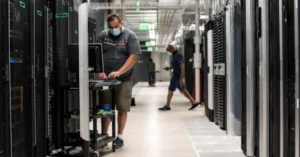TOC
Table of Contents
One of the most common and disruptive forms of malware is ransomware. A single attack can result in millions of dollars in damage and hundreds of hours of recovery time before the victim can use the infected devices once again.
A primer on ransomware and the dangers of extortion software is the focus of this article. We examine the current ransomware landscape and provide advice on best counter this cyber threat by explaining what this malware is and how it works.
Definition
Ransomware is malware that prevents users from accessing files or devices until they pay a ransom. Most ransomware encrypts data, allowing attackers to demand payment in exchange for the decryption key. If the victim refuses to comply, the attacker will delete the key, rendering all encrypted data useless.
A single PC or mobile device can be infected by ransomware, but an attack can also target an entire network. The motivation is usually financial, but some attacks are designed to sabotage the target. Ransomware’s consequences can be devastating, resulting in:
- Business and customer data are lost.
- Allowing a data breach to occur could result in legal consequences.
- Long periods of inactivity.
- A loss of customers as a result of a reputational hit.
- A time-consuming and expensive recovery process that restores the network to its pre-attack state.
- Infrastructure damage over time.
The amount demanded a ransom can range from a few hundred dollars to millions of dollars. Most attackers require payment in Bitcoins, a cryptocurrency that allows the criminal to remain anonymous once the money is received.
Ransomware prevention must be a part of every cybersecurity strategy because no business or system is safe. Hackers use ransomware to attack small businesses, large corporations, government agencies, and individual users. This malware poses a threat to all operating systems, including Windows, Linux, and Mac.
Current Trends
As criminals develop new tactics for exploiting advances in cloud computing, virtualization, and edge computing, ransomware will continue to evolve. The following are the most important trends that are currently influencing the ransomware landscape:
- Criminals are targeting managed service providers (MSPs) more than ever before. Breaching a single MSP allows an attacker to infect clients while also allowing them to attack multiple targets with a single breach.
- Better defenses: Businesses are employing new tactics to stay ahead of hackers. Improved heuristics, behavior analysis, and bait files are assisting businesses in predicting attacks rather than reacting to threats.
- Hackers are continuing to target companies that operate from their homes. Employees who work from home using personal devices are the primary target.
- Attackers are concentrating their efforts on industries that the pandemic has disrupted. Criminals target healthcare and education facilities because they know their data is valuable and likely poorly protected.
- There’s more Ransomware-as-a-Service than ever before: Ransomware-as-a-Service is a subscription-based “service” that allows hackers to carry out attacks using third-party tools. The creators of the tool are paid a percentage of each successful breach, while the “clients” are free to concentrate solely on spreading malware.
- Conti, Avvadon, REvil (ex Sodinokibi), Netwalker, and Babuk were the most prominent ransomware threats in 2021. The most common attack vectors are phishing emails, RDP exploits, and software flaws.
How does ransomware Work?
All ransomware attacks start with a virus that gets into the computer. Once the ransomware has infiltrated the computer, it runs a malicious file. Do what it needs to do based on the type of malware.
- It starts encrypting when it finds the target data (Microsoft Word documents, images, databases, and so on) and starts searching for it.
- As soon as you connect to the hacker’s C&C server, you can take control of the computer.
- Take care of everything automatically.
- Make sure to look for valuable data and set up the process for getting it out of the country.
When the program is done with its job, the user loses access to files or the whole computer. The message on the device says that the system has been infected with ransomware and that the only way to get back in control or get your data back is to pay a ransom. The two most common ways that programs show this message are.
- A background that turns into a ransom note when you move your mouse over it
Each encrypted folder has text files inside of it. - Every ransom usually comes with two deadlines so that the victim is forced to pay. The first deadline is when they say they’re going to double the ransom, and the second is when they’re going to do that. Second: The attacker wants to delete the decryption key.
Asymmetric encryption is used by most ransomware. To encrypt and decrypt data, this type of cryptography uses a pair of keys that are unique to each other. Most ransomware programs use a different decryption key for each file they want to get back. To get the data back, you need to use the hacker’s key stored on his server.
How Does Ransomware Spread?
This is a list of the most common ways that ransomware is spread.
- Email phishing campaigns that send out a link or attachment that isn’t safe.
- A very well-targeted spear-phishing attack.
- People can be tricked into doing things they don’t want to do (baiting, scareware, pretexting, tricks on social media, etc.).
- Malvertising.
- Exploit kits are found on malicious websites.
- A worm made by someone else takes advantage of a flaw in the system (such as a faulty RDP setup or a flaw due to poor server management).
- A piece of hardware that has been harmed (namely USBs and laptops).
- Unnecessary add-ons are added to downloads.
Most top-tier ransomware can spread through the network after it infects the first person. Many times, the infected device is not the goal of the attack. Most programs use self-propagation mechanisms to spread to other systems to get to databases and servers. This is how most of them work.
Who is the Target of Ransomware?
Criminals who use ransomware attack anyone they can, but their primary targets are businesses that appear to be willing to pay a hefty ransom quickly. The majority of attacks target people who:
- Client information should be kept safe (for example, banks or law firms).
- Do you need access to files right away? (hospitals and clinics).
- Have data that is irreplaceable (government agencies).
- Rely on an understaffed security team (public institutions and SMBs).
- With a diverse user base and a high volume of file sharing (universities).
If your company does not meet these requirements, you should be concerned. Criminals are opportunistic and will seize any opportunity to prey on the weak. Furthermore, because some ransomware spreads automatically across the internet, any company is a potential target regardless of size, industry, or income level.
What are the Different Types of Ransomware?
While all ransomware programs have the same basic structure, there are two main types of cyberattacks:
- Locker ransomware (Computer locker): A type of malware locks users out of their computers and prevents them from booting up. The victim is usually given limited access to the locked system so that they can interact with the hacker.
- Crypto ransomware (data locker): A type of ransomware that encrypts sensitive information without locking the user out of the device. Financial data, private customer information, large work projects, photos, tax information, videos, and other types of information are common targets.
Locker ransomware is a less dangerous type of ransomware because it does not spread over the internet or corrupt files. This malware is also easier to remove without paying the ransom, so locker hackers frequently pose as cops to pressure the victim into paying the ransom as soon as possible.
Criminals began developing a new ransomware variant as businesses started to rely on better data backups. The goal of a Doxware attack is to steal data from the target system. If the program steals the data, the attacker demands a ransom and threatens to leak or sell the files to the highest bidder if the ransom is not paid.
Some programs can exfiltrate data before encrypting them. An attacker can use both extortion tactics by combining crypto and Doxware capabilities.
How Can Ransomware Be Avoided?
Ransomware is difficult to eradicate, but basic security hygiene, employee awareness, and proactive response planning can all help. The following are the best practices that every business should follow to protect themselves from ransomware.
- Update your devices and systems with the most recent security patches.
- Ascertain that the team follows sound email security procedures.
- Organize a security awareness training session to ensure that everyone on the team understands how ransomware works.
- To prevent lateral movement between systems, use network segmentation.
- Ensure that employees understand how to use anti-malware and anti-virus software.
- To avoid malicious ads and drive-by downloads, emphasize the importance of safe surfing.
- Enhance the overall security of the network.
- To protect critical systems and databases, use zero-trust policies and multi-factor authentication.
- Keep an eye on network activity for any unusual activity.
- Regular updates and traffic monitoring ensure that endpoints do not become entry points.
- Make a plan for dealing with an incident.
Using immutable backups is the best way to reduce the threat of ransomware. Intruders cannot encrypt, delete, or alter the information in this type of backup because it is uneditable. To reduce the risk of losing data if ransomware strikes, back up data several times per day.
What Should You Do If Ransomware hits you?
Even the best ransomware protection isn’t always enough to prevent an attack. If you are attacked, follow the steps below to minimize the damage and get back to business as soon as possible:
- Isolate the source of the issue. Remove the infected device from the network and turn it off. Remove the possibility of lateral movement because the program is likely looking for other devices and drives.
- Examine the damage. Examine each device that appears to be suspicious. Look for files with unusual extensions, encrypted data, and reports of users having trouble opening files. Make a list of all the affected systems, such as network devices, cloud storage, external hard drives, laptops, PCs, and other portable devices.
- Find patient 0 on the map. You need to figure out where the attack came from. Examine your anti-virus and malware programs and your EDR system and monitoring platform for any alerts.
- Recognize the Ransomware. You must determine the type of ransomware that has infected your organization. Most ransom notes reveal the perpetrator’s identity, but you can also use a search engine to look up the message text and find the perpetrator that way.
- Make a call to the authorities. Officers may be able to assist in identifying the attacker, and there’s a chance they have the decryption key for the ransomware in question.
- To restore data, use backups. Each infected system should be restored from a backup. If you have immutable backups, the attack will not affect the backup file, restoring each device to its previous safe state. After that, scan devices for back doors with an anti-malware solution.
Should Companies Pay the Ransom?
Paying the ransom is tempting if a company does not have a data backup and faces weeks or months of recovery. Before making a decision, keep the following in mind.
- You may never receive the decryption key. Many victims have paid the ransom only to be left empty-handed.
- It’s possible that the decryption key won’t work. Because ransomware authors aren’t in the file recovery business, they don’t spend much time making sure the decryption works.
- It’s possible that your files are too corrupted. Some ransomware programs corrupt files beyond repair to ensure that encryption happens as quickly as possible. Even a decryption key won’t be able to restore the files if this is the case.
- You’ve turned into a desirable target. A company that has paid the ransom in the past is an appealing target for a new attack. The same group of people may strike again in the future or inform their colleagues about which businesses are willing to meet the demands.
- Criminals can still leak your information. Even if you pay the ransom, if attackers steal your data, nothing will stop them from selling it to the highest bidder.
Rather than debating whether paying the ransom is the best option, make sure your company is prepared to deal with a ransomware attack. You will never be in a position where you must consider paying the ransom if you take the proper precautions and backups.




Leave a Reply
You must be logged in to post a comment.